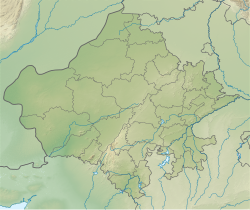
Back قلعة شيتور Arabic قلعة شيتورجاره ARZ Крэпасць Чытаргарх Byelorussian Fuerte de Chittorgarh Spanish چیتورگره Persian Chitorin linnake Finnish Fort de Chittor French מבצר צ'יטורגר HE चित्तौड़गढ़ दुर्ग Hindi Benteng Chittor ID
| Chittor Fort | |
|---|---|
| Part of Chittorgarh | |
| Rajasthan, India | |
 A view of Chittorgarh Fort, Rajasthan, India | |
| Coordinates | 24°53′11″N 74°38′49″E / 24.8863°N 74.647°E |
| Floor area | 280 ha (691.9 acres) |
| Height | 180 m (590.6 ft) |
| Site information | |
| Controlled by | S Parmar |
| Site history | |
| Battles/wars | Siege of Chittorgarh (1303) Battle of Chittor (1321) Siege of Chittorgarh (1535) Siege of Chittorgarh (1567–1568) |
| Garrison information | |
| Occupants | Mauryans of Chittorgarh, Guhilas of Medapata, Sisodias of Mewar |
| Type | Cultural |
| Criteria | ii, iii |
| Designated | 2014 (36th session) |
| Part of | Hill Forts of Rajasthan |
| Reference no. | 247 |
| Region | South Asia |
Chittorgarh (literally Chittor Fort), also known as Chittod Fort, is one of the largest forts in India. It is a UNESCO World Heritage Site. The fort was the capital of Mewar and is located in the present-day city of Chittorgarh. It sprawls over a hill 180 m (590.6 ft) in height spread over an area of 280 ha (691.9 acres) above the plains of the valley drained by the Berach River. The fort covers 65 historic structures, which include four palaces, 19 large temples, 20 large water bodies, 4 memorials and a few victory towers.
In 2013, at the 37th session of the World Heritage Committee held in Phnom Penh, Cambodia, a group of six Hill Forts of Rajasthan, including Chittor Fort, was declared a UNESCO World Heritage Site.[1]
- ^ Centre, UNESCO World Heritage. "Hill Forts of Rajasthan". UNESCO World Heritage Centre. Retrieved 1 July 2024.

